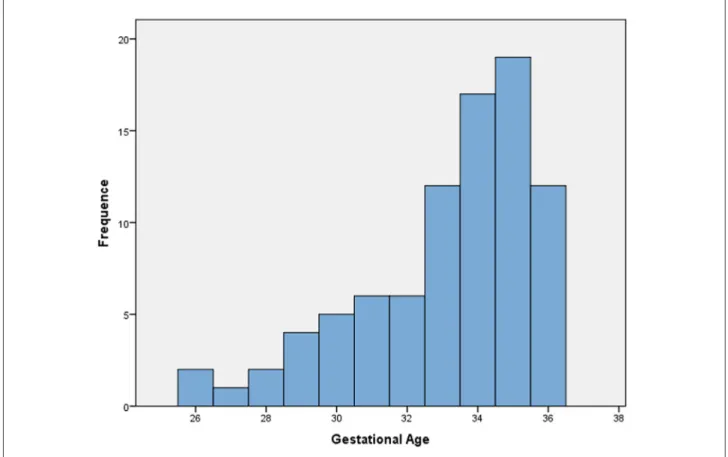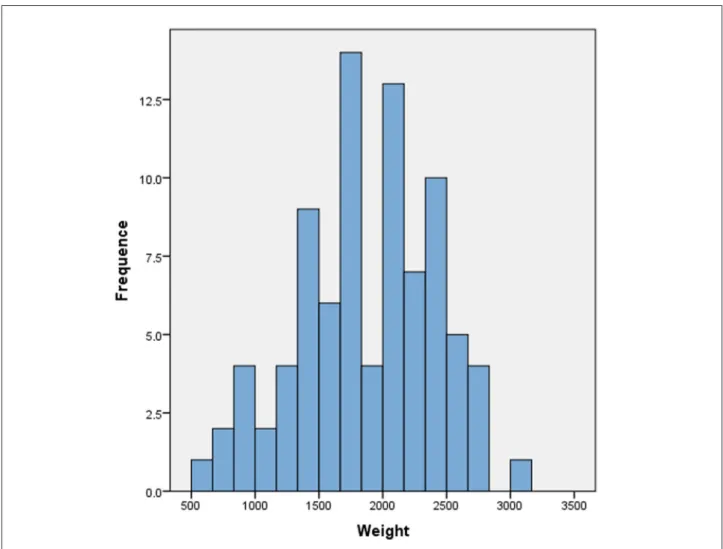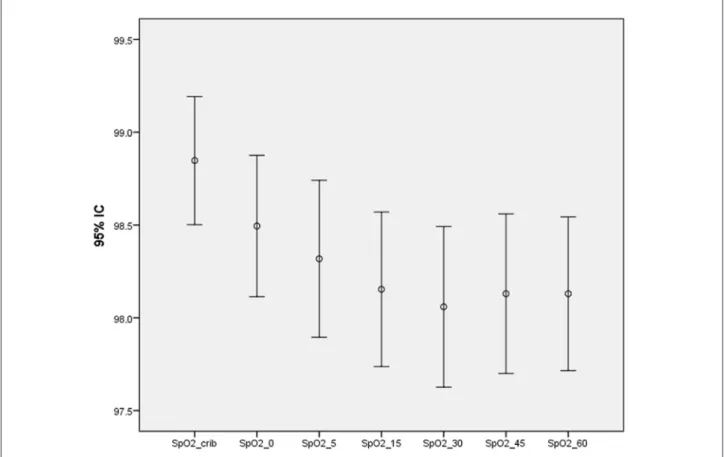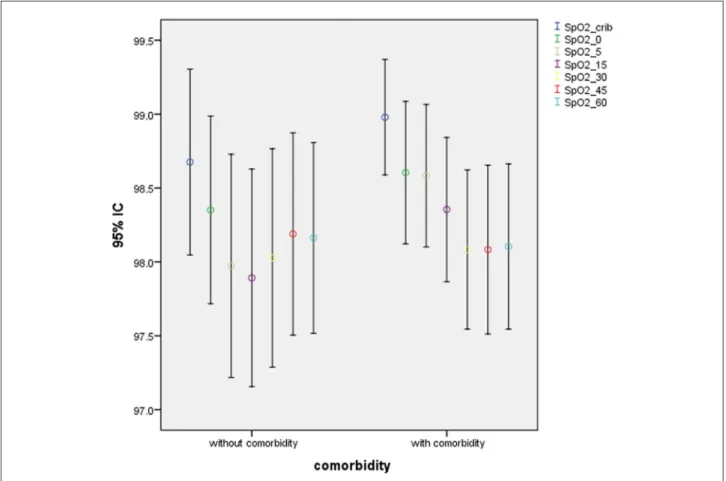Received: 2018 Jul 19; revised: 2018 Nov 12; accepted: 2018 Dec 03; published online: 2019 May 23
Car Seat Challenge Test in the
Neonatal Intensive Care Unit
Ana Brás1, Cristina Pratinha1, Susana Oliveira1, Maria
Barbieri-Figueiredo2,3, Madalena Ramos1, Hercília Guimarães1,3
1Neonatal Intensive Care Unit, Department of Pediatrics, Centro Hospitalar Universitário São João, Porto,
Portugal
2Nursing School of Porto and CINTESIS, Porto, Portugal 3Faculty of Medicine of Porto University, Porto, Portugal
Abstract
Background: In Portugal, there is a Guideline of the Directorate General of Health that requires that newborns with hospital discharge should be transported home in a proper and safe restraint system, aligned with AAP policy statements. In the Neonatal Intensive Care Unit (NICU) of Centro Hospitalar Universitário de S. João (Porto, Portugal), the Car Seat Challenge Test has been carried out since 2005, and there is not any study about its safety.
Objective: This study aims to report the responses of preterm infants discharged home in 2015 and to develop a standardized procedure for its performance.
Methods: This is a descriptive, retrospective, observational, non-experimental study. Data was collected from the NICU nursing records with a form designed for this purpose. Study variables were: gender, gestational age, birth weight, and comorbidities. Saturation of oxygen in arterial blood (SpO2) and heart rate (HR) values were measured at rest (in the crib), in the car seat chair at time 0, 5, 15, 30, 45 and 60 minutes.
Results: During the year 2015, 86 preterm infants were discharged home, and all had values of SpO2 and HR within the reference range for this age group, during the Car Seat Challenge Test. The values decrease slightly from the measurement at 15 minutes for both SpO2 and HR. Infants with and without comorbidities had similar values of SpO2 (97-99.5%) and HR (135-155 beats per minute [bpm]), with a small decrease at 15 minutes. Infants with comorbidities did not regain saturation values after 30 minutes.
Conclusion: The Car Seat Challenge Test has been performed systematically in the NICU since 2005. Data analyzed demonstrated it is safe. A standardized procedure was developed to provide harmonization of criteria.
Keywords
Infant, premature, child restraint systems, intensive care units, neonatal, Portugal.
Corresponding author
Ana Brás, Serviço de Neonatologia, Centro Hospitalar Universitário São João, Alameda Professor Hernani Monteiro 4200-319 Porto, Portugal; email: anabras74@gmail.com.
How to cite
Brás A, Pratinha C, Oliveira S, Barbieri-Figueiredo M, Ramos M, Guimarães H. Car Seat Challenge Test in the Neonatal Intensive Care Unit. J Pediatr Neonat Individual Med. 2019;8(2):e080202. doi: 10.7363/080202.
Introduction
In Portugal, there has been a Guideline of the Directorate General of Health since 2010 that requires that newborns with hospital discharge should be transported home in a proper and safe restraint system, whether they are healthy newborns, preterm infants or infants with special needs [1].
This requirement aligns with American Academy of Pediatrics (AAP) policy statements, published in 1990, to be implemented before hospital discharge of the newborns, so that each newborn leaves the hospital in an appropriate restraint system suitable to maturity and health condition. This policy included health professional’s education and parental education for restraint systems proper use in the car [2].
These policies were refined in 1991 based on studies that showed oxygen desaturation in preterm infants in the seated position. Standards were then published, advising a period of observation of these newborns in the restraint system before hospital discharge [3]. This procedure in the Anglo-Saxon literature has been named as “Infant Car Seat Challenge – ICSC” or “Car Seat Challenge Test”.
In 1996 the same committee extended the recommendations concerning hospital discharge to infants with low birth weight (BW) [4]. The recommendations on the observation period were updated in 1999. This period of observation of the newborn in the restraint system before discharge should have a duration of at least 90 to 120 minutes or the duration of the trip home if longer [5].
Consensus about criteria for discontinuing the Car Seat Challenge Test has not been achieved. In a study by DeGrazia, in 2007, the criteria considered for discontinuing the test are: apnea longer than 20 seconds, more than two consecutive episodes of tachypnea (respiratory rate > 70 cycles per minute) associated with saturation of oxygen in arterial blood (SpO2) < 93%, bradycardia below 80 beats per minute (bpm) without spontaneous recovery, SpO2 < 93% without spontaneous recovery, or other signs and symptoms of respiratory distress. The author considers spontaneous recovery the increased of the heart rate (HR) and the oxygen saturation in 10 seconds, without the intervention of health professionals [6].
Davis et al. in 2013 proposed as failure criteria bradycardia (80 bpm) for a period longer than 10 seconds and SpO2 < 90% for a period longer than 10 seconds [7]. In 2014, Davis et al. added other criteria as apnea ≥ 20 seconds and the observation of breathing difficulties as failures criteria in the test [8].
In 2007, the Portuguese Society of Pediatrics published recommendations about newborn trans-portation in the car, which includes premature infants positioning in the restraint system, and their monitoring for 60 minutes, 1 week before hospital discharge [9].
The Car Seat Challenge Test is not free of controversy. For example, due to the inconsistency of data and scarcity of evidence, the Canadian Paediatric Society [10] does not recommend routine Car Seat Challenge Test before discharge for preterm infants. They recommend that parents should be counseled regarding safe car seat use and be able to demonstrate appropriate technique and practice – preferably using their car seat – before their infant is discharged from the hospital.
In the Neonatal Intensive Care Unit (NICU), of Centro Hospitalar Universitário de S. João (CHUSJ), Porto, Portugal, the test is carried out the day before discharge. The Car Seat Challenge Test began in 2005, in partnership with a Non-Governmental Organization dedicated to the Promotion of Child Security (APSI – Associação para a Promoção da Segurança Infantil). This association provided restraint systems (car seats) legally approved, although there have been records of this test only from 2007.
In the bibliographic search performed so far, we are not aware of any published study on this test in Portugal.
The aims of this study are: i) to report the historical aspects of the Car Seat Challenge Test in the NICU of CHUSJ (Porto, Portugal); ii) to analyze the behavior of preterm infants submitted to the Car Seat Challenge Test in 2015, according to the parameters recorded (values of SpO2 and HR) and its relationship with the BW, gestational age (GA) and comorbidity; and iii) to develop a standardized procedure for performing Car Seat Challenge Test in the NICU.
Materials and methods
This is a descriptive, retrospective, obser-vational, non-experimental, study whose data was obtained from the records of the Car Seat Challenge Test existing in the NICU of CHUSJ, since 2007. This unit was one of the first Neonatal Units in Portugal, established in 1983, within a University Hospital, having a total of 17 cribs with 9 intensive care beds. It is a level 3 unit, a reference center for congenital heart disease (CHD) (for the North of Portugal) and also a NIDCAP training center [11].
In this NICU, the test is performed for 60 minutes, whenever possible in the own infant restraint system, or the restraint system of the NICU, in its absence. Our restraint systems have 3 point harness and 45-degree angle of the seat and are approved by ECE R44/03 European norm. This test is performed on all newborns before discharge from the hospital, regardless of their diagnosis on admission, particularly preterm infants, term newborns with cardiac disease and surgical disorders.
During the test, the HR and SpO2 of the newborn are monitored and recorded using monitors Philips Intellivue MP30 Neonatal and Hewlett Packard – Omnicare 24 Neonatal Viridea 24. The presence of bradycardia and SpO2 < 95% is considered fail regardless of the duration of bradycardia and desaturation. The respiratory frequency (RF) has been monitored during the test but not recorded so far. The records do not allow to identify the number of times the infant failed the test and the repetitions.
The lack of precise criteria related to the values and duration of bradycardia and desaturation is one of the gaps in this test procedure in our practice, which will be improved with this study. We aim to develop a standardized procedure for the Car Seat Challenge Test that can be evaluated in the NICU of CHUSJ and later implemented as Guideline at national level.
The data was collected from the record sheets of the NICU and the clinical information system with a form designed for this purpose. The study variables were: gender, GA, BW, oxygen saturation, HR and comorbidity. The values of the SpO2 and HR were obtained from the measurements recorded at rest (in the crib), in the car seat chair at 0, 5, 15, 30, 45 and 60 minutes. GA was expressed in full weeks, and the weight was expressed in grams (g).
The data was extracted to a Microsoft® Excel® spreadsheet, and the data processing was carried out using the program SPSS® v.22.
Ethical considerations
The study was approved by the Ethics Commission of the CHUSJ, and the International recommendations for Biomedical research were followed. There were not registered names of infants, or any other kind of identification. All records, manuscripts or electronic, were kept in a locked cabinet in the NICU, to which only the researchers had access.
Results
The Car Seat Challenge Test in the NICU of CHUSJ began in 2005, but there has been documentation only since 2007. Tab. 1 shows the flow of patients from 2007 till 2015, evidencing that about 400 infants per year were hospitalized in the NICU. About 50% of these infants were discharged directly home; however, there is a discrepancy between the tests conducted and the number of discharges for the household. This discrepancy probably was due to loss of records
Table 1. Patient flow in the NICU of CHUSJ, 2007-2015.
Year 2007 2008 2009 2010 2011 2012 2013 2014 2015
Total in-patients 400 367 407 421 446 384 445 372 391
Deceased patients 21 15 19 14 16 19 18 13 17
Transferred to other units 206 197 242 230 245 130 195 140 184
Discharged home 174 155 146 179 186 232 232 218 193
since they were written on paper and not digitally. In 2011, the informatics nursing records began, but the Car Seat Challenge Test records remained on paper. Data will be analyzed in detail for the year 2015 because this was the most recent completed year at the beginning of this study.
In 2015, 153 Car Seat Challenge Tests were performed, among which 86 were preterm infants (44% female and 56% male). The GA of these infants age was between 26 and 36 weeks with more than 50% above 33 weeks as shown in Fig. 1. BW ranged between 660 g and 3,015 g (Fig. 2). At discharge, the average age was 37 weeks, and the average weight was 2,288 g.
All preterm infants submitted to the Car Seat Challenge Test had normal values of HR and SpO2 during the test, although we verified that from 15 minutes both values decreased slightly (Fig. 3 and Fig. 4). Two of the infants were dependent on oxygen, administered by nasal cannula (< 0.25 liters/min).
Out of the 86 preterm infants analyzed, 57% have comorbidities such as surgical and cardiac conditions. Two of the infants had the presence of neurological morbidity. The HR behavior was similar to those who had not comorbidities, with a small decrease at 15 minutes. The SpO2 behavior
was slightly different, noting that after 30 minutes preterm infants with comorbidity did not regain saturation values (Fig. 5 and Fig. 6).
Discussion
The Car Seat Challenge Test consists in a period of observation of newborns in the transportation restraint system before hospital discharge because there is evidence of oxygen desaturation in preterm infants in the upright position as the AAP [3, 4] policies recommend and later research studies [6, 7] demonstrated. In this study, data was recorded for the preterm infants that were admitted to the NICU during the year 2015.
The test duration of 60 minutes is due to the Portuguese Society of Pediatrics’ recommendations [9] and the fact that most distances from hospital to household do not exceed this time. Portugal is a small country, rectangle-shaped, with about 90,000 square kilometers and 45 public Neonatal Units [12].
There is a scarcity of studies about the Car Seat Challenge Test, and they show a diversity of test duration [13]. In a survey conducted in 2012, in New York/New England [7], of the 89 institutions with current Car Seat Challenge Test policies,
Figure 2. Birth weight (BW) of preterm newborns hospitalized in the NICU of CHUSJ and discharged home in 2015.
Figure 4. Infant Car Seat Challenge Test, saturation of oxygen in arterial blood (SpO2) patterns.
Figure 6. Infant Car Seat Challenge Test, saturation of oxygen in arterial blood (SpO2) comparison: preterm infants without
and with comorbidity.
only 55% had tests that lasted a minimum of 90 minutes, consistent with the AAP guidelines. In this study, 39% tested for less than 89 minutes and 5 institutions tested for only the duration of the car ride home.
One of the limitations of our study is the absence of criteria for failure. This NICU lacked precise criteria related to the values and duration of bradycardia, desaturation or occurrence of apnea [6, 7]. The RF has been monitored during the test but not recorded so far. The records do not allow identifying the number of times the infant failed the test and the repetitions. These are some gaps in this test procedure in our practice, which will be improved with this study.
In the records analyzed, in the 86 Car Seat Challenge Tests performed in preterm infants in 2015, only 3 infants had SpO2 < 93%. The spon-taneous recovery of saturation was not recorded. The HR values ranged between 97 bpm and 192 bpm. The study by Davis et al. [7] evidenced that failure saturations used at the participant institutions (n = 89) ranged from < 80% to < 93%. The most commonly cited threshold was < 90%. Increasing length of time in the car seat position has been
associated with decreased saturation. In our study, we confirmed these results, and the minimum values were observed at 30 minutes of the test duration. The behavior of preterm infants submitted to the Car Seat Challenge Test did not show statistical differences according to BW, GA or comorbidities. Nevertheless, preterm infants with comorbidities did not regain SpO2 saturation values after 30 minutes. These results are corroborated by the study of DeGrazia, which evidenced that the chances of having an oxygen desaturation event were unclear for infants with and without comorbidity [6].
It is consensual that hospitals should develop protocols to regulate car safety seat observation before discharge for preterm and low-weight infants as well as infants at risk of oxygen desaturation such as infants who have undergone congenital heart surgery. This procedure must be undertaken by a trained professional, namely NICU nurses [14].
The standardized procedure for performing Car Seat Challenge Test in the NICU, presented in Tab. 2, is a result of the outcomes of the study performed in the CHUSJ’s NICU as well as evidence obtained from the literature reviewed.
This protocol will be implemented after being submitted to ordinary hospital guidelines approval and evaluated after a 6-month testing period. Conclusions
All preterm infants submitted to the Car Seat Challenge Test in 2015 had average values of HR and SpO2 during the test. When positioned in their car seats, some infants experienced only brief oxygen desaturations, which are considered safe.
The HR behavior in preterm infants who had comorbidities and those who had not comorbidities was similar, with a small decrease at 15 minutes. The SpO2 behavior was slightly different, noting that after 30 minutes preterm
infants with comorbidity did not regain saturation values.
From this study, we could question, whether the duration of the test was prolonged up to 120 minutes, what would happen to the HR and SpO2 values of these preterm infants. The RF was not evaluated in the test because it was not part of the parameters recommended by the NICU. We consider pertinent to include it in the protocol for future tests, taking into account the literature analyzed and its inclusion in the establishment of criteria.
The standardized procedure for performing Car Seat Challenge Test in the NICU is a result of the outcomes of the study performed as well as evidence obtained from the literature reviewed. It will be implemented in the CHUSJ’s NICU and evaluated after a 6-month testing period.
Table 2. Car Seat Challenge Test procedure.
A – Equipment
• Infant’s own car seat if available or unit car seat retrain system (ECE R44/03 or 04 European norm) • Monitor: Philips Intellivue MP30 Neonatal and Hewlett Packard – Omnicare 24 Neonatal Viridea 24 • Kendall neonatal ECG electrodes
• Kendall Oximeter
• Bed sheets and cloth diaper for rolls • Car Seat Challenge Test record form
B – Procedure
1. Cleanse chest and foot sites for leads/probe. On chest, apply:
• Red (right arm) electrode directly below the clavicle and near the right shoulder; • Yellow (left arm) electrode directly below the clavicle and near the left shoulder; • Black electrode directly on the lower left abdomen.
On either foot, apply:
• O2 transducer probe (be sure that the light emitter and photodetector are opposite to each other).
2. Turn on monitor and select a lead where the electrocardiogram wave is completely free from electrical or muscle artifact. Assess for SpO2 pleth for adequate wave free of artifact. Also assess for good perfusion to foot with oximeter probe in place and for stable SpO2 (93% in crib).
3. Place infant in the car seat with bed sheets and cloth diaper rolls for a good adjustment. 4. If artifact is noted, reposition electrodes or O2 transducer probe.
5. Complete the infant Car Seat Challenge Test form and document use of rolls. 6. Begin Car Seat Challenge Test.
7. Monitor infant for 60 minutes or the duration of the trip home if longer at a maximum of 120 minutes.
8. Discontinue testing if infant experiences a desaturation event. This event is defined as an apnea episode > 20 seconds in duration, more than 2 consecutive episodes of periodic breathing interrupted by tachypnea (RF > 70) which are associated with SpO2 < 93%, bradycardia with HR < 80 bpm without spontaneous recovery, SpO2 < 93% without spontaneous recovery, or if
other difficulties in breathing are demonstrated. Spontaneous recovery is defined as a consistent rise in HR or SpO2 within 10 seconds without intervention.
9. If the infant passes the Car Seat Challenge Test, he/she is able to be discharged home in his/her own car seat. If the infant fails the test, it must be repeated after 24 hours.
10. After the second Car Seat Challenge Test failure, the infant has to be assessed in order to repeat the test or the need to be transported in the hard car bed.
C – Parental education
• The rear-facing car seat should be age- and/or weight-appropriate, never have been in an accident, not have missing or broken pieces, and meet European guidelines evidenced by reference on seat (ECE R44/03 – 04 or R129).
• Car seat should have a 3 or 5 point harness, 25 centimeters from lower harness to bottom, and 13.7 centimeters or less between back and crotch strap.
• Premature and small infants should not be placed in a car seat with shields, abdominal pads, or arm rests. • Shoulder straps should be in the lowest slots and fit snug.
• No rolls or padding should be placed behind or beneath the infant. The infant should be unwrapped with arms and legs free to be positioned appropriately around restraints and buttocks to back of seat.
• If the car seat does not meet these criteria, one will be provided for testing. HR: heart rate; RF: respiratory frequency; SpO2: saturation of oxygen in arterial blood.
Acknowledgements
We thank Teresa Martins (Nursing School of Porto & CINTESIS) for providing assistance with statistical analysis.
Declaration of interest
The Authors certify that there is no conflict of interest with any financial organization regarding the material discussed in the manuscript. Funding source: no funding was secured for this study.
References
1. Direcção-Geral da Saúde. Transporte de Crianças em Automóvel desde a Alta da Maternidade. Orientação da Direcção-Geral da Saúde. 2010;1(9).
2. American Academy of Pediatrics Committee on Accident and Poison Prevention. Safe Transportation of Newborns Discharged from the Hospital. Pediatrics. 1990;86(3):486-7.
3. American Academy of Pediatrics Committee on Injury and Poison Prevention and Committee on Fetus and Newborn. Safe transportation of Premature Infants. Pediatrics. 1991;87(1):120-2. 4. American Academy of Pediatrics Committee on Injury and
Poison Prevention and Committee on Fetus and Newborn. Safe Transportation of Premature and Low Birth Weight Infants. Pediatrics. 1996;97(5):758-60.
5. American Academy of Pediatrics Committee on Injury and Poison Prevention. Safe Transportation of Newborns at Hospital Discharge. Pediatrics. 1999;104(4):986-7.
6. DeGrazia M. Stability of the Infant Car seat Challenge and Risk Factors for Oxygen Desaturation Events. JOGNN. 2007;36(4):300-7.
7. Davis NL, Zenchenko Y, Lever A, Rhein L. Car seat Safety for Preterm Neonates: Implementation and Testing Parameters of the Infant Car seat Challenge. Academic Pediatrics. 2013;13(3): 272-7.
8. Davis NL, Gregory ML, Rhein L. Test-retest Reliability of the Infant Car seat Challenge. J Perinatol. 2014;34(1):54-8.
9. Sociedade Portuguesa de Pediatria. Secção de Neonatologia. Transporte dos Recém-Nascidos Prematuros in Nascer Pre ma-turo: Um Manual para os Pais dos Bebés Prematuros. Available at: http://www.lusoneonatologia.com/site/upload/File/O%20 transporte%20em%20automovel%20-%20Como%20levar%20 o%20prematuro.pdf, date of publication: 2007, last access: Novem- ber 2015.
10. Canadian Paediatric Society. Assessment of cardiorespiratory stability using the infant car seat challenge before discharge in preterm infants (<37 weeks’ gestational age) Position Statement Committee(s): Fetus and Newborn Committee. Available at: http://www.cps.ca/en/documents/position/infant-car-seat-challenge, date of publication: 2016, last access: November 2016.
11. Guimarães H, Guedes B, Almeida S, Rodrigues M, Ramos M, Maia T, Clemente F. Parents in the Neonatal Intensive Care Unit of “Hospital de São João” (Porto, Portugal). J Pediatr Neonat Individual Med. 2015;4(1):e040120.
12. CNSMCA. Carta Hospitalar Materna, da Criança e do Adolescente. 2012.
13. Pilley E, McGuire W. Pre-discharge “car seat challenge” for preventing morbidity and mortality in preterm infants. Cochrane Database Syst Rev. 2006;25(1):1465-858.
14. Bull JM, Engle WA. Safe Transportation of Preterm and Low Birth Weight Infants at Hospital Discharge. Pediatrics. 2009;123(5):1424-9.




